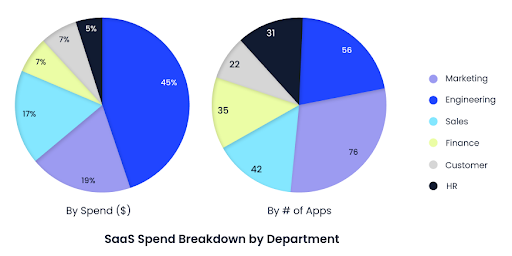
How To Build a Cost-Conscious Culture at Startups
Even during these uncertain economic conditions, SaaS spending by organisations doesn’t seem to slow down, with Gartner forecasting that the total spending on SaaS will reach $197 billion in 2023.
And it is a daunting challenge for startup CFOs to ensure that each dollar spent on SaaS returns significant value and aligns with the company’s financial goals. Purchasing SaaS just for the sake of it will result in underutilisation and redundancies, ultimately leading to poor ROI and wasted spend.
While SaaS applications are essential for business operations, it is also equally prudent to understand how you spend on them.
CFOs should be responsible for building a cost-conscious culture in startups to ensure users spend responsibly and make the best use of their available resources. Here’s how you do it:
1. Promote Financial Responsibility Among Your Team
Lack of awareness can be a driving factor behind uncontrolled spending. So, educate the team and let them know about the consequences of uncontrolled spending, how it will impact your startup’s bottom line, and why it is essential to stick to allocated budgets.
CFOs analyse benchmarks to ensure the company is paying the right price for the product. Share these benchmarks with your team and demonstrate how your spending stacks up compared to industry peers.

This data from CloudEagle’s 2023 SaaS spend report shows that the Engineering team spends the most on SaaS applications. Still, the Marketing and Sales team has the highest number of unused applications. Presenting real-time data like this to your team will encourage them to use allocated resources more effectively.
2. Encourage users to self-assess application ROI
While educating your team, emphasise that the ROI should drive SaaS purchases an app can deliver, not merely to fulfill a task the user desires. Most users purchase an application to complete a time-sensitive task and abandon it once their use case is complete, leading to redundancies.
CFOs must ask users to provide a complete ROI analysis of the product before raising a purchase request. Users must answer questions like:
- What advantages will the application bring to the organisation?
- How much ROI will this app generate?
- What is the expected duration of the application's usage by the team?
- How quickly will it influence our revenue or expenses?
- What are the initial costs associated with procuring and integrating the software?
- Will there be additional/hidden costs regarding support, upgrades, etc.?
- Is the application within the allocated budget?
This Q&A-type ROI analysis approach will ensure users use the allocated budget effectively.
When enforced at the grassroots level, this strategy will organically cultivate a cost-conscious culture, resulting in controlled spending and consistent investment returns.
3. Establish individual budgets for each department
CFOs should work closely with other department heads to set realistic budgets and regularly review financial performance against these budgets. Allocate software budgets for each department based on their usage patterns. This approach will instill a sense of cost-consciousness throughout the organisation.
Budgeting also prevents users from purchasing unsanctioned applications (shadow IT) on their own using corporate credit cards.
CFOs must closely monitor credit card purchases and implement measures to detect shadow IT usage before it becomes entrenched in the organisation and impacts revenue.
Setting budget limits encourages departments to prioritise ROI when acquiring applications rather than making acquisitions solely for the sake of it.
4. Ensuring Financial Sensibility: Policies and Penalties
Although mandatory training sessions are valuable for educating your executive team and nurturing a culture of financial prudence, they should not be your exclusive strategy.
Complementing these sessions by establishing well-defined policies and associated penalties is vital. By doing so, you can firmly establish cost-consciousness as an unwavering top priority from the perspective of the CFO.
Centralise SaaS buying. Educate your team about how this centralised system operates, establish clear guidelines for its implementation, and create penalties for those who violate the new purchasing policies.
This approach makes it more likely that people will follow the established financial guidelines, ensuring that the culture of cost-effectiveness continues over the long term.
5. Opt for Automation Over Spreadsheets
Suppose your goal is to instill a culture of cost-consciousness within your organisation and prevent users from buying unauthorised applications. In that case, it's essential to transition from using spreadsheets to utilising spend management platforms.
It’s hard to believe that some organisations and CFOs continue to rely on manual methods such as spreadsheets for spend tracking and then wonder why their investments fail to translate into increased revenue.
Educating the team using real-time user data and creating budgets based on usage patterns is only possible using a spend management platform, as it provides complete real-time visibility on app usage, spend, contracts, vendors, etc.
It can also automatically send proactive alerts when a user purchases an unsanctioned application, catching shadow IT during the early stages. Using a full-stack spend management and procurement solution, you can create a centralised SaaS procurement process and keep your spend from spiraling out of control.
In conclusion, by proactively implementing these strategies, startups can tackle the challenges of rising software spend. More importantly, you can cultivate a cost-conscious culture that bolsters financial stability and optimises resource utilisation.

